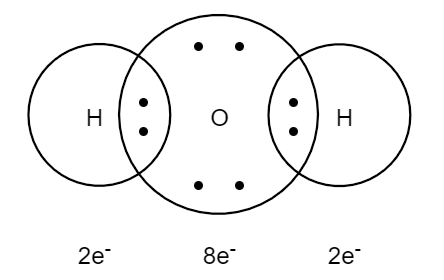
Draw the Lewis dot structure for the formation of water molecules.
Answer
552.6k+ views
Hint: Number of attempts were made to explain the chemical bond formation in terms of electrons. But a satisfactory explanation was given by Kossel and Lewis in . They have given some logical explanation of valence that was based on the inertness of the noble gases. To obtain a stable configuration lewis dot structure is made where electrons are represented as dots.
Complete step by step answer:
Lewis pictured the atom in terms of a positively charged ‘Kernel’ (the nucleus plus the electrons and the outer shell that could accommodate a maximum of eight electrons.
Lewis postulated that atoms should be succeeded in the stable octet when they are attached by chemical bonds.
The dot represents electrons, such structures are referred to as Lewis dot structure.
The Lewis dot structure can be drawn for other molecules also, in which the combining atoms may be identical or different. Let us discuss some important conditions that they follow are as follows:
1.Each bond is formed as a result of sharing of an electron pair between the atoms.
2.Each combining atom contributes at least one electron to the shared pair.
3.The combining atoms attain the outer shell noble gas configuration as a result of the sharing of electrons.

Additional information:
Formal charge: Lewis dot structures in general do not represent the actual shape of molecules. In case of polyatomic ions, the net charge is processed by the ion as whole and not by a particular atom.
The formal charge of an atom in a polyatomic molecule or ion may be defined as the difference between the number of valence electrons of that atom in an isolated or free state and the number of electrons assigned to that atom in the Lewis structure. It is expressed as:
$F.C=V.E-N.B-\dfrac{1}{2}B$
where, $F.C$ is the formal charge on an atom in a Lewis structure, $V.E$ is the total number of valence electrons in free atom, $N.B$ is the total number of non – bonding (lone pair) electrons and $B$ is the total number of bonding (shared) electrons.
Note: The octet rule is quite useful for understanding the structures of most of the organic compounds and it applies to the second period elements of the periodic table. There are three types of exceptions to the octet rule:
Odd number of electrons: For example, $NO$
One or more atoms possess more than eight electrons. For example, $S{{F}_{6}}$
One or more atoms possess less than eight electrons. For example, $BC{{l}_{3}}$
Complete step by step answer:
Lewis pictured the atom in terms of a positively charged ‘Kernel’ (the nucleus plus the electrons and the outer shell that could accommodate a maximum of eight electrons.
Lewis postulated that atoms should be succeeded in the stable octet when they are attached by chemical bonds.
The dot represents electrons, such structures are referred to as Lewis dot structure.
The Lewis dot structure can be drawn for other molecules also, in which the combining atoms may be identical or different. Let us discuss some important conditions that they follow are as follows:
1.Each bond is formed as a result of sharing of an electron pair between the atoms.
2.Each combining atom contributes at least one electron to the shared pair.
3.The combining atoms attain the outer shell noble gas configuration as a result of the sharing of electrons.

Additional information:
Formal charge: Lewis dot structures in general do not represent the actual shape of molecules. In case of polyatomic ions, the net charge is processed by the ion as whole and not by a particular atom.
The formal charge of an atom in a polyatomic molecule or ion may be defined as the difference between the number of valence electrons of that atom in an isolated or free state and the number of electrons assigned to that atom in the Lewis structure. It is expressed as:
$F.C=V.E-N.B-\dfrac{1}{2}B$
where, $F.C$ is the formal charge on an atom in a Lewis structure, $V.E$ is the total number of valence electrons in free atom, $N.B$ is the total number of non – bonding (lone pair) electrons and $B$ is the total number of bonding (shared) electrons.
Note: The octet rule is quite useful for understanding the structures of most of the organic compounds and it applies to the second period elements of the periodic table. There are three types of exceptions to the octet rule:
Odd number of electrons: For example, $NO$
One or more atoms possess more than eight electrons. For example, $S{{F}_{6}}$
One or more atoms possess less than eight electrons. For example, $BC{{l}_{3}}$
Recently Updated Pages
Master Class 12 Business Studies: Engaging Questions & Answers for Success

Master Class 12 Economics: Engaging Questions & Answers for Success

Master Class 12 English: Engaging Questions & Answers for Success

Master Class 12 Maths: Engaging Questions & Answers for Success

Master Class 12 Social Science: Engaging Questions & Answers for Success

Master Class 12 Chemistry: Engaging Questions & Answers for Success

Trending doubts
What is meant by exothermic and endothermic reactions class 11 chemistry CBSE

Which animal has three hearts class 11 biology CBSE

10 examples of friction in our daily life

One Metric ton is equal to kg A 10000 B 1000 C 100 class 11 physics CBSE

1 Quintal is equal to a 110 kg b 10 kg c 100kg d 1000 class 11 physics CBSE

Difference Between Prokaryotic Cells and Eukaryotic Cells




